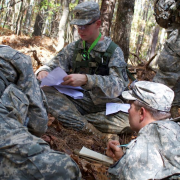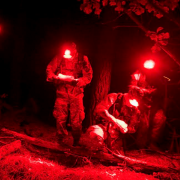The highlight of Appalachian State ROTC training took place a recent November weekend at Riverbend Park just outside of Hickory North Carolina. Twenty two juniors and a few select sophomores and freshmen made the journey to be assessed on basic soldering skills and leadership ability. For many, this was a make or break event. Would they show the necessary leadership ability to continue in the program? The first skill that these cadets were tested on was the ability to navigate the land through terrain association and use of a map and compass. The cadets were each given five points to locate in a certain amount of time. If you found three out of five, you were good to go. If you found less than three, your ROTC career was in jeopardy. The cadets conducted both day and night land navigation. For the most part, the cadets were successful in their endeavors to navigate the land. After a night of sleep, the cadets were awoken bright and early to begin conducting their tactical lanes. Each individual was given a chance to be a squad leader, conducting either an ambush, a squad attack, or a squad reconnaissance. The leaders were graded on their ability to adapt to changes, overcome obstacles, and most importantly to successfully complete the mission. After each mission, the squad leaders would be led through an after action review process. This was a time to identify positive and negative aspects of the operation. After each cadet had been given a chance to lead an operation, all personnel assembled back at the tactical operations center and prepared to return to Appalachian State University. Overall, the training was run and conducted in a professional and proficient manner. The cadets received training that would assist them in becoming the most competent future warrior leaders of the United States Army. Cadet Ian Berry MS IV.



